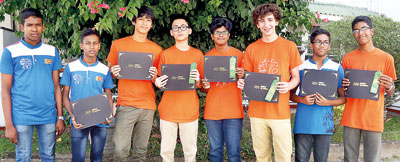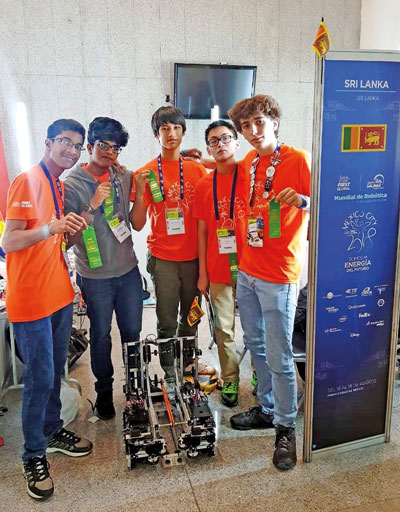Robotics on a global scale
It is the second time; team Sri Lanka competed for the world’s robotic Olympics. This year, a group of 8 young inventors from the Elizabeth Moir School, President’s College Embilipitiya and St. John’s College Jaffna got to gather and designed a robot kit for the FIRST Global Challenge (FGC) 2018.

Lankan Team with their Judges (Technical )Award.Pic by M.A. Pushpa Kumara
FGC is an annual international robotics competition which offers a platform for youth 14-18 years to cultivate their knowledge in Science, Technology, Engineering and Mathematics (STEM subjects). Themed around ‘14 Grand Challenges of Engineering’ identified by National Academies of Engineering, youth of the world gathered to address the biggest challenges faced by humanity in modern times.
This year’s competition, held in Mexico’s Arena Ciudad de Mexico saw 161 teams taking part. Aptly themed ‘Energy Impact,’ the games were designed to signify the use of fossil fuels, solar and wind power to generate energy.
Team Sri Lanka, represented by five young students; Daniel Joung, Dao Thanh Cong, Felix Deemer, Syanthan Selvakumaran of the Elizabeth Moir School and Sherwin Leonard of St. John’s College Jaffna are back in the country with promising achievements.
The robot kit designed by the team received the Judges (Technical) Award for the team’s unique performance, outstanding design and engineering skills.
In the challenge game, two village alliances each comprised of three countries battle to generate more energy than the other, utilizing the four power generators on the game field- solar factory, wind turbine, reaction plant and combustion plant. Each game runs for two and a half minutes as the alliances are free to strategize the game approaches.
In the solar factory, the robot delivers a solar panel to the village power station where a human player places it in the solar array. The robot should crank the wind turbine three times to generate power and both village alliances should fill all the eight slots of the shared reaction plant with fuel cubes. Points are given for inserting fuel cubes to the low goal or high goal of the combustion plant and teams receive bonus points if the robots are parked at the village power station at the end of the game.
Full of excitement for what he experienced in Mexico, Felix Deemer, the president of the schools’ coding and robotics club talked about his hobby, “complex, yet interesting”- coding. “Coding or programming is setting the instructions of a robot controlled by a remote controller. In simple terms it is what exactly the robot needs to do when we press a button on the remote,” explains Felix. FGC 2018 being his first international robotic competition, Felix enjoyed the diversity of teams, ideas and creative robotic designs.
Felix also mentioned the instance where “the whole team got frantic” when their robot got disconnected from the hand held tablet and froze on the field. “That is the risk,” Felix says, “Even if you do everything right, there can be some software or technical problem which is beyond your control.”
To everyone’s astonishment, the alliance team of Sri Lanka, Jamaica and South Africa together ended up scoring the highest points of 1286 in one of the qualifying matches.
Captain of team Sri Lanka, Daniel Joung, was mostly involved in the designing and engineering of the robot, and notes the efficiency of the Sri Lanka’s robot kit in scoring at the combustion plant by picking up and lifting the fuel cubes. Being the captain of the schools’ football team, Daniel would observe the rotation of the shoulder joint in throw-ins in football. The simple physical moment inspired the robot’s lifting mechanism which turned out to be unique from all other countries.
Syanthan Selvakumaran assisted with the designing which defined the lifting mechanism as the cantilever mechanism. During the four months of hard work building and testing the robot, Daniel recalls while laughing how the duo spent excessive hours at school doing the designing sketches.

The team in Mexico
Dao Thanh Cong is the “driver,” fondly teased by the group. As Dao had the remote controller, during the game he had to “improvise whatever happend in the game field and follow the strategies.” A skilled video game player and the captain of the schools’ chess team, Dao is complimented by Daniel and Syanthan,“He is a really good driver and has perfect hand eye coordination.”
Sherwin Leonard, passionate in mechanics enjoyed the experience, mentioning his long journeys from Jaffna to Colombo while they were making the robot.
“A coder should be careful in technical coding, if something goes wrong in programming, the robot could be damaged,” says Hamza Anver who initially joined the team as a mechanical helper, later assisting in coding too.
Lasith Kodagoda and Navod Vitharana from President’s College, Embilipitiya were a part of the designing team of the robot kit. “We are happy for this lifetime opportunity to share new ideas and enjoyed working with the team,” Novod expresses.
The team was supported by their mentors, Dilum Rathnasinghe, Shivashankaran Satchithananthan, Jekhan Aruliah and Srimali Fernando as the team manger.


